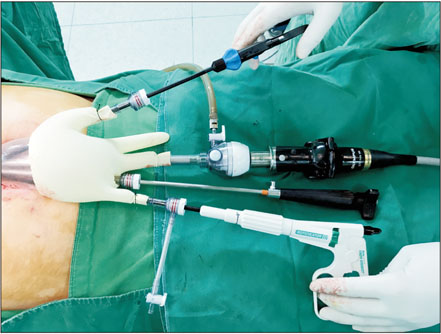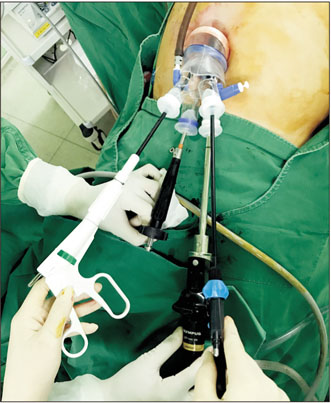Ann Surg Treat Res.
2018 Aug;95(2):80-86. 10.4174/astr.2018.95.2.80.
Evolution of the Konyang Standard Method for single incision laparoscopic cholecystectomy: the result from a thousand case of a single center experience
- Affiliations
-
- 1Department of Surgery, Konyang University Hospital, Daejeon, Korea. choiins@kyuh.ac.kr
- KMID: 2417773
- DOI: http://doi.org/10.4174/astr.2018.95.2.80
Abstract
- PURPOSE
Single incision laparoscopic cholecystectomy (SILC) is increasingly performed worldwide. Accordingly, the Konyang Standard Method (KSM) for SILC has been developed over the past 6 years. We report the outcomes of our procedures.
METHODS
Between April 2010 and December 2016, 1,005 patients underwent SILC at Konyang University Hospital. Initially 3-channel SILC with KSM was changed to 4-channel SILC using a modified technique with a snake retractor for exposure of Calot triangle; we called this a modified KSM (mKSM). Recently, we have used a commercial 4-channel (Glove) port for simplicity.
RESULTS
SILC was performed in 323 patients with the KSM, in 645 with the mKSM, and in 37 with the commercial 4-channel port. Age was not significantly different between the 3 groups (P = 0.942). The postoperative hospital days (P = 0.051), operative time (P < 0.001) and intraoperative bleeding volume (P < 0.001) were significantly improved in the 3 groups. Drain insertion (P = 0.214), additional port insertion (P = 0.639), and postoperative complications (P = 0.608) were not significantly different in all groups. Postoperative complications were evaluated with the Clavien-Dindo classification. There were 3 cases (0.9%) over grade IIIb (bile duct injury, incisional hernia, duodenal perforation, or small bowel injury) with KSM and 3 (0.5%) with mKSM.
CONCLUSION
We evaluated the evolution of the KSM for SILC. The use of the mKSM with a commercial 4-channel port may be the safest and most effective method for SILC.
MeSH Terms
Figure
Cited by 1 articles
-
A large-cohort comparison between single incision laparoscopic cholecystectomy and conventional laparoscopic cholecystectomy from a single center; 2080 cases
Ye-Ji Lee, Ju Ik Moon, In-Seok Choi, Sang-Eok Lee, Nak-Song Sung, Seong-Wook Kwon, Dae-Sung Yoon, Won-Jun Choi, Si-Min Park
Ann Hepatobiliary Pancreat Surg. 2018;22(4):367-373. doi: 10.14701/ahbps.2018.22.4.367.
Reference
-
1. Begos DG, Modlin IM. Laparoscopic cholecystectomy: from gimmick to gold standard. J Clin Gastroenterol. 1994; 19:325–330.
Article2. Csikesz NG, Singla A, Murphy MM, Tseng JF, Shah SA. Surgeon volume metrics in laparoscopic cholecystectomy. Dig Dis Sci. 2010; 55:2398–2405.
Article3. Soper NJ, Stockmann PT, Dunnegan DL, Ashley SW. Laparoscopic cholecystectomy. The new ‘gold standard’? Arch Surg. 1992; 127:917–921.
Article4. Schirmer BD, Edge SB, Dix J, Hyser MJ, Hanks JB, Jones RS. Laparoscopic cholecystectomy. Treatment of choice for symptomatic cholelithiasis. Ann Surg. 1991; 213:665–676.5. Wilson RG, Macintyre IM, Nixon SJ, Saunders JH, Varma JS, King PM. Laparoscopic cholecystectomy as a safe and effective treatment for severe acute cholecystitis. BMJ. 1992; 305:394–396.
Article6. Muhe E. Long-term follow-up after laparoscopic cholecystectomy. Endoscopy. 1992; 24:754–758.
Article7. Podolsky ER, Curcillo PG 2nd. Reduced-port surgery: preservation of the critical view in single-port-access cholecystectomy. Surg Endosc. 2010; 24:3038–3043.
Article8. Navarra G, Pozza E, Occhionorelli S, Carcoforo P, Donini I. One-wound laparoscopic cholecystectomy. Br J Surg. 1997; 84:695.
Article9. Hodgett SE, Hernandez JM, Morton CA, Ross SB, Albrink M, Rosemurgy AS. Laparoendoscopic single site (LESS) cholecystectomy. J Gastrointest Surg. 2009; 13:188–192.
Article10. Son JI, Choi IS, Moon JI, Ra YM, Lee SE, Choi WJ, et al. Single incision laparoscopic cholecystectomy using Konyang Standard Method. Ann Surg Treat Res. 2014; 86:177–183.
Article11. Edwards C, Bradshaw A, Ahearne P, Dematos P, Humble T, Johnson R, et al. Single-incision laparoscopic cholecystectomy is feasible: initial experience with 80 cases. Surg Endosc. 2010; 24:2241–2247.
Article12. Rivas H, Varela E, Scott D. Single-incision laparoscopic cholecystectomy: initial evaluation of a large series of patients. Surg Endosc. 2010; 24:1403–1412.
Article13. Piskun G, Rajpal S. Transumbilical laparoscopic cholecystectomy utilizes no incisions outside the umbilicus. J Laparoendosc Adv Surg Tech A. 1999; 9:361–364.
Article14. Podolsky ER, Mouhlas A, Wu AS, Poor AE, Curcillo PG 2nd. Single Port Access (SPA) laparoscopic ventral hernia repair: initial report of 30 cases. Surg Endosc. 2010; 24:1557–1561.
Article15. Ceci F, Di Grazia C, Cipriani B, Nicodemi S, Corelli S, Pecchia M, et al. Cholecystectomy by single incision laparoscopic surgery (SILS): early experience and technique standardization. G Chir. 2012; 33:280–284.16. Cuesta MA, Berends F, Veenhof AA. The “invisible cholecystectomy”: a transumbilical laparoscopic operation without a scar. Surg Endosc. 2008; 22:1211–1213.
Article17. Tacchino R, Greco F, Matera D. Single-incision laparoscopic cholecystectomy: surgery without a visible scar. Surg Endosc. 2009; 23:896–899.
Article18. Palanivelu C, Rajan PS, Rangarajan M, Parthasarathi R, Senthilnathan P, Praveenraj P. Transumbilical flexible endoscopic cholecystectomy in humans: first feasibility study using a hybrid technique. Endoscopy. 2008; 40:428–431.
Article19. Zhu JF, Hu H, Ma YZ, Xu MZ, Li F. Transumbilical endoscopic surgery: a preliminary clinical report. Surg Endosc. 2009; 23:813–817.
Article20. Mathisen O, Soreide O, Bergan A. Laparoscopic cholecystectomy: bile duct and vascular injuries: management and outcome. Scand J Gastroenterol. 2002; 37:476–481.
Article21. Melton GB, Lillemoe KD, Cameron JL, Sauter PA, Coleman J, Yeo CJ. Major bile duct injuries associated with laparoscopic cholecystectomy: effect of surgical repair on quality of life. Ann Surg. 2002; 235:888–895.22. Stewart L, Way LW. Bile duct injuries during laparoscopic cholecystectomy. Factors that influence the results of treatment. Arch Surg. 1995; 130:1123–1128.23. Strasberg SM, Hertl M, Soper NJ. An analysis of the problem of biliary injury during laparoscopic cholecystectomy. J Am Coll Surg. 1995; 180:101–125.24. Joseph M, Phillips MR, Farrell TM, Rupp CC. Single incision laparoscopic cholecystectomy is associated with a higher bile duct injury rate: a review and a word of caution. Ann Surg. 2012; 256:1–6.25. Antoniou SA, Pointner R, Granderath FA. Single-incision laparoscopic cholecystectomy: a systematic review. Surg Endosc. 2011; 25:367–377.
Article26. Pisanu A, Reccia I, Porceddu G, Uccheddu A. Meta-analysis of prospective randomized studies comparing single-incision laparoscopic cholecystectomy (SILC) and conventional multiport laparoscopic cholecystectomy (CMLC). J Gastrointest Surg. 2012; 16:1790–1801.
Article
- Full Text Links
- Actions
-
Cited
- CITED
-
- Close
- Share
- Similar articles
-
- Single incision laparoscopic cholecystectomy for patients with Mirizzi syndrome
- Comparison of Single-Incision Robotic Cholecystectomy, Single-Incision Laparoscopic Cholecystectomy and 3-Port Laparoscopic Cholecystectomy -Postoperative Pain, Cosmetic Outcome and Surgeon's Workload
- Comparison of outcomes of single incision robotic cholecystectomy and single incision laparoscopic cholecystectomy
- Single incision laparoscopic cholecystectomy using Konyang Standard Method
- Comparison of Single Incision and Three Port Laparoscopic Cholecystectomy





